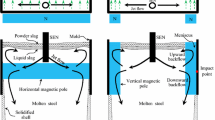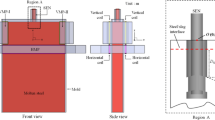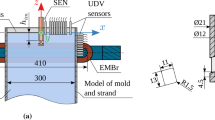Abstract
The general flow characteristics of the molten steel and the behavior of molten steel and liquid slag interface (level fluctuation) in the mold with a new type of electromagnetic brake, freestanding adjustable combination electromagnetic brake (FAC-EMBr), was investigated by numerical simulation. The influences of the magnetic induction intensity, the submerged entry nozzle (SEN) immersion depth, the SEN port angle, and casting speed on the effect of FAC-EMBr are investigated. The results show that electromagnetic field formed by FAC-EMBr can cover the jet flow impact region, the upward backflow region, and the meniscus region simultaneously. With the increase of magnetic flux density, the jet flow impact intensity and the molten steel velocity in the upward and downward backflow regions are effectively suppressed, the meniscus wave height also decreases gradually, and the level fluctuation tends to be stable. For the influence of SEN port angle and SEN depth on the effect of FAC-EMBr mold, the results show that the molten steel velocity in the three main influence regions are all effectively depressed with increase of the value of SEN port angle and SEN depth. Even though under the condition of high casting speed (VC = 2.2 m/min), the application of FAC-EMBr can achieve effective braking effect.




















Similar content being viewed by others
References
B K Li: Iron & Steel, 2005, vol.40, pp.33-36.
R Singh: Master of Science in Mechanical Engineering, University of Illinois at Urbana-Champaign, United States, 2013.
Z Q Liu, F S Qi, B K Li and M F Jiang: J.Northeast Univ.(Natural Science),2014, vol.35, pp.1733-37.
R Sánchez-Pérez, R D Morales, L García-Demedices, J P Ramos and M. Díaz-Cruz: Metall. Mater. Trans. B, 2004, vol.35, pp.85-99.
M M Yavuz: Steel Res. Int., 2011, vol.82, pp.809-18.
K Cukierski and B G.Thomas: Metall. Mater. Trans. B, 2008, vol.39B, pp.94-107.
L Xu, E G Wang, C Karcher, A Y Deng and X J Xu: Metall. Mater. Trans. B, 2018, vol.49B, pp. 2779-93.
S G Hernandez, R D Morales and E T Alonso: Ironmak. Steelmak., 2010, vol.37, pp.360-68.
K H Moon, H K Shin, B J Kim, J Y Chung, Y S Hwang and K J Yoon: ISIJ Int., 1996, vol. 36(S), pp. 201–03.
Z Li, E G Wang and Y Xu: J. Iron Steel Res. Int., 2018, vol.25, pp.366-77.
D S Kim, W S Kim and K H Cho: ISIJ Int., 2000, vol.40, 670-76.
M Y Ha, H G Lee and S H Seong: J. Mater. Process. Technol., 2003, vol.133, pp.322-39.
A. Lehman, G. Tallback, and A. Rullgard: ABB Rev., 1996, No. 4, pp. 4–10.
K Takatani: ISIJ Int., 2003, vol.43, pp.915-22.
H Shen, B Liu and L Wang: Int. Int. J.Cast. Metals Res., 2005, vol.18, pp.209-13.
H Yamamura, T Toh, H Harada, E Takeuchi and T Ishii: ISIJ Int., 2001, vol.41, pp.1229-35.
Z D Qian and Y L Wu: ISIJ Int., 2004, vol.44, pp. 100-07.
K Timmel, S Eckert and G Gerbeth: Metall. Mater. Trans. B, 2011, vol.42B, pp. 68-80.
X C Miao, K Timmel, D Lucas, Z M Ren, S Ecket and G Gerbeth: Metall. Mater. Trans. B, 2012, vol.43B, pp.954-72.
H Jia, Z Q Zhang, Z Yu, K Deng, Z S Lei and Z M Ren: Acta Metall. Sin., 2012, vol.48, pp.1049-56.
S Kollberg and P LoFgren: Rev Metall.-Paris, 2005, vol. 102, pp. 431–40.
R Singh, B G Thomas and S P Vanka: Metall. Mater. Trans. B, 2014, vol.45B, pp.1098-115.
H Q Yu, M Y Zhu and J Wang: J. Iron Steel Res. Int., 2010, vol.17, pp. 5-11.
Z Li, E G Wang, L T Zhang, Y Xu and A Y Deng: Metall. Mater. Trans. B, 2017, vol.48B, pp.2389-402.
H Q Yu and M Y Zhu: Acta Metall. Sin., 2008, vol.44, pp.1141-48.
Acknowledgments
This work was financially supported by the National Natural Science Foundation of China (51804154), the college and university scientific research projects in Liaoning province (L2017LQN020) and the 111 Project 2.0 of China (No. BP0719037). The authors also thank the referees for their work, which greatly contributed to this article.
Author information
Authors and Affiliations
Corresponding author
Additional information
Publisher's Note
Springer Nature remains neutral with regard to jurisdictional claims in published maps and institutional affiliations.
Manuscript submitted March 10, 2020.
Electronic supplementary material
Below is the link to the electronic supplementary material.
Supplementary material 2 (WMV 406 kb)
Appendix A
Appendix A
In the mold, the molten metal is governed by the following equations:
where u, ∇p, \( \nu \)and Fg and Fm are velocity, pressure gradient, kinematic viscosity, gravity and the electromagnetic (Lorentz) forces, respectively. As the fluid flow in the mold is fully turbulent, the standard k−ε model (two equations) is adopted in the simulation, where k and ε denote the turbulence kinetic energy and its dissipation rate, respectively. Therefore, the Reynolds-Average–Navier stokes (RANS) equations can be written as follows:
where Sij is defined as that mean strain-rate tensor:
\( - \overline{{u_{i}^{'} u_{j}^{'} }} \) is the Reynolds stress tensor. U and P are the mean parts of u and p, respectively. u′ is the fluctuation part of u. The k−ε transport equations can be expressed as
where σk and σε denote the turbulent Prandtl numbers for k and ε, respectively. C1ε and C2ε are constant values: 1.44 and 1.92 in the present simulation. \( \nu_{t} \)is the kinetic eddy viscosity:
where Cµ is a constant value, 0.09.
In Eq. [A4], Fm is determined by
where j is the induced current, which is determined by Ohm’s law:
where B is the magnetic flux density.
Volume of Fluid (VOF) model is selected as the multiphase model to capture the steel/slag interface behavior. The steel/slag interface is captured by solving Eq. [A3]. For steel phase,
where mst→sl denotes the mass transfer from the steel phase to the slag face, and vice versa. αst denotes the volume of fraction of phase steel in the cell. αst = 0, αst = 1, and 0 < αst < 1 denote the cell is empty of phase steel, full of phase steel, and the cell contains the interface between the phase steel and other phase, respectively. Sst is the source term of steel phase. In the present research, the continuity equation is shared by steel and slag phase. The mass transfer between different phases is neglected. Equation A11 can be simplified as
For the slag phase, the volume of fraction is obtained by the constrain condition:
Rights and permissions
About this article
Cite this article
Li, Z., Zhang, L., Ma, D. et al. Numerical Simulation on Flow Characteristic of Molten Steel in the Mold with Freestanding Adjustable Combination Electromagnetic Brake. Metall Mater Trans B 51, 2609–2627 (2020). https://doi.org/10.1007/s11663-020-01950-5
Received:
Accepted:
Published:
Issue Date:
DOI: https://doi.org/10.1007/s11663-020-01950-5




